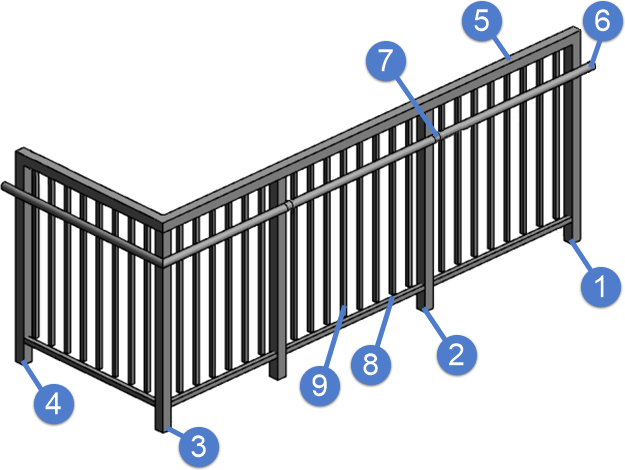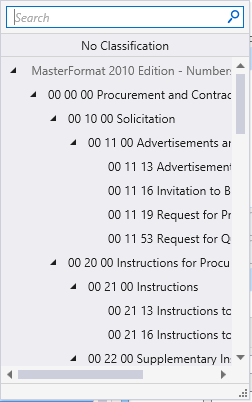Place Railing
 Used to create both
handrails and guardrails in the same assembly.
Used to create both
handrails and guardrails in the same assembly.
Note:
Placement is completed using the controls found on the
Placement ribbon tab and the
Property Panel which is loaded with the active
Building element catalog items and properties.
Accessed from:
Tip: You can
create railings that follow the slope of a stair. In addition creating and
placing handrail assemblies, you can:
- Create and place railings that contain both handrails and guard rails in egress stairs.
- Create and place railings that contain both handrails and guard rails along ramps.
- Place guardrails along mezzanine and other floor openings.
- Place handrails along a wall; along the outside of a stair tower; and along a corridor.
Railing components
Rails – the horizontal elements of a railing. Some common uses for rails are:- Guard Rail (5) – the upper most rail, usually installed at a height of 42 inches. Guard rails are required over any kind of floor opening in the US.
- Hand Rail
(6) – the rail, usually installed two inches
from the wall, that is held by a person walking beside the railing.
The height of a handrail is measured vertically from the floor to the top of the railing. For handrails that are associated with a stair, the height is measured vertically from the front edge of the stair to the top of the railing.
- Bottom Rail (8) – the lower most rail that is connected to the upper rail by balusters.
- Kick Plate (not illustrated) – a solid plate along the bottom of a railing, usually to prevent small objects from falling off the edge of an opening.
- Posts (1, 2, 3, 4) – the major vertical elements of a railing that connect the assembly to the stair or floor. Posts normally repeat in a pattern every four to eight feet, measured center-to-center.
- Mounting brackets (7) – fittings that attach handrails to the wall, or to the posts.
Placement tab
Select Place Railing also opens the Placement contextual ribbon tab which is used to control the physical placement and positioning of newly placed railings.
Note:
The
Placement tab opens on the ribbon when placing
Building elements. The
Placement tab contains settings specific to the
Building element being placed that are used to define the position, orientation
or dimensions of the Building element being placed. Also available on the
Placement tab, are a collection of Building
common tools selected specifically because of their relevance to the Building
element being placed.
Railing Properties
| Setting | Description |
|---|---|
| Catalog Type Selector | Used to select from available Catalog Types. Selections made here updates the Catalog Item Selector combo box. |
| Catalog Item Selector |
Used to select from available
Catalog Items. The
Catalog Item Selector combo box contains
several options and settings designed to make it easier to find the exact
catalog item you need to place/change.
The
Catalog Item list also includes user
defined assemblies, and RFA catalog items, if any.
|
| Catalog Tools | A split button located to the right of the
Catalog Item Selector contains tools to
assist with managing catalog data prior to placement of selected catalog items.
Note: The
Save Catalog Item and
Save Catalog Item As... tools perform
administrative tasks on DataGroup System catalogs. Administrators and users may
want to hide the tool icons to avoid incidental or unwanted changes to their
firm's dataset by setting the user configuration variables
BB_CATALOGITEM_ADMIN_IN_PLACECMDS
and
BB_CATALOGITEM_SAVEAS_IN_PLACECMDS to "0", respectively.
|
| Preview |
Displays the selected catalog item in the preview
window. This display changes and the preview updates as various options are
chosen. The preview also changes dynamically with some of the
prominent settings on the Placement tab, e.g Height, Rotation angle, etc. A
right-click in the Preview opens a
Show/Hide Viewing Tools option menu:
|
| Properties list - toolbar |
Used to manage catalog item properties during
placement or modification. Catalog item properties define the catalog item
instance in the model, and are accountable in the DataGroup System data
management tools. You can place a catalog item with its default property values
or you can change property values as needed, place an instance in the model,
and optionally save the changes to the catalog.
The Properties combo box contains tools for sorting and searching the properties list:
|
| Railing Parameters | |
| Construction Phase | Lists design and construction phase properties for walls such as New Construction, Future Construction, and Items to be Moved. |
| Identification | Lists identification properties for the active catalog item type. |
| IFC Override | Lists IFC properties not automatically mapped to DataGroup System properties that can be manipulated for export. |
| Classification | Building Classification Systems are supported by the DataGroup System. MasterFormat, OmniClass, and UniFormat property values can be associated with any Building element. Click the Value cell to open the Classification System selection combo box. The combo box is populated with selected classification system property values. It can be resized by clicking on the combo box's bottom right corner. Search for properties by name. Search results are displayed in the classifications hierarchy. Double click a property to select it. This action also closes the selection menu. The selected property displays in the selected classification system property value (on the Properties list). |
Note:
Information in the
Value column rows can be completed by selecting
the applicable cell to activate an editor field, an option menu, or a pop up
dialog. This data is written to the element properties. Properties displayed
with grey text are read only. Some of these are set in the placement tool's
Placement tab, and can be modified there. The
dividing bar between the
Property, and
Value columns can be moved to change the width
of either area, or resize the dialog. A vertical and horizontal scroll bars are
available to scroll and adjust
Properties panel viewing and the display of
data.









 (
( (
( (
( (
( (
( (
( (
( (
( (
( (
(





 (
( (
( (
(